Hair Braid Drawing Step By Step
How to Draw a Braid
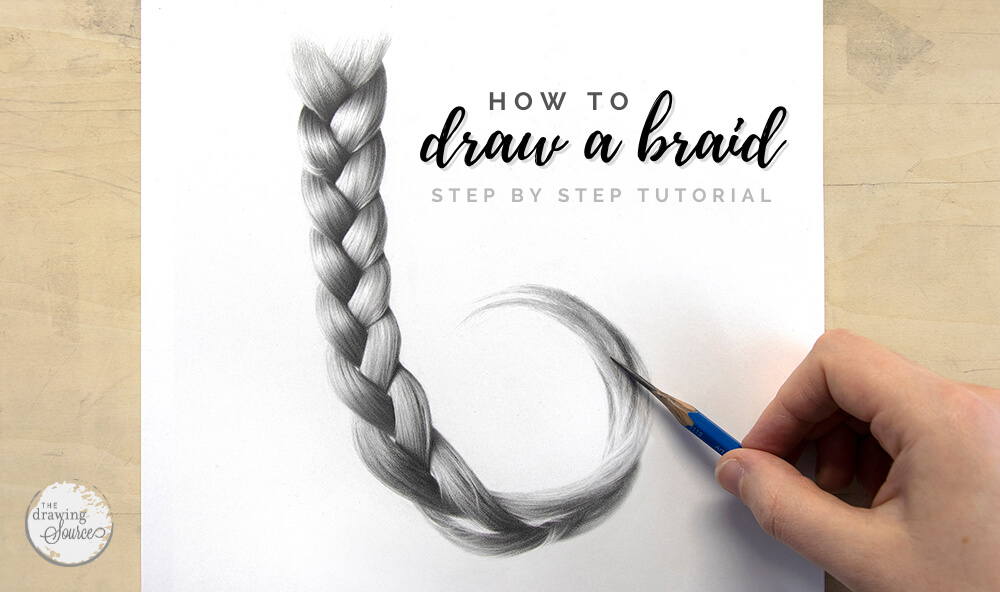
Learn how to draw a braid realistically in this step by step tutorial!
A hairstyle can have many functions in a portrait drawing. It can be drawn very simply to complete a portrait without drawing too much attention to itself, as it does in this portrait shading tutorial. It can be one of the main features of a portrait, as it is in this hair drawing tutorial, or it can be the focal point of your drawing (or even the sole subject matter, as it is in my braid drawing here). However you choose to include hair in your portrait drawings, it is an exciting subject matter to challenge yourself with.
Suggested Prerequisite Video Lessons
Because this is a more advanced drawing tutorial, I have some suggested prerequisite video lessons for you to watch in order to get the most out of this lesson:
- First, take my free Mini-Course (video lessons!) to learn the essential concepts needed for realistic drawing.
- Make sure that you know how to sharpen a drawing pencil, as you'll notice how sharp my pencils are in the final stages of shading this braid drawing.
- How to gain stability and control of your drawing pencil: throughout this drawing I constantly use the techniques that I demonstrate in this video, as they are absolutely essential for drawing the details in the braid.
- Three ways to use a kneaded eraser for realistic drawing: I use my kneaded eraser just as much as I use my pencil in this drawing!
Finally, download the reference photo of this braid at the bottom of this page so that you can follow along with the tutorial, or draw along with me.
How to Draw a Braid
Materials Used in this Tutorial
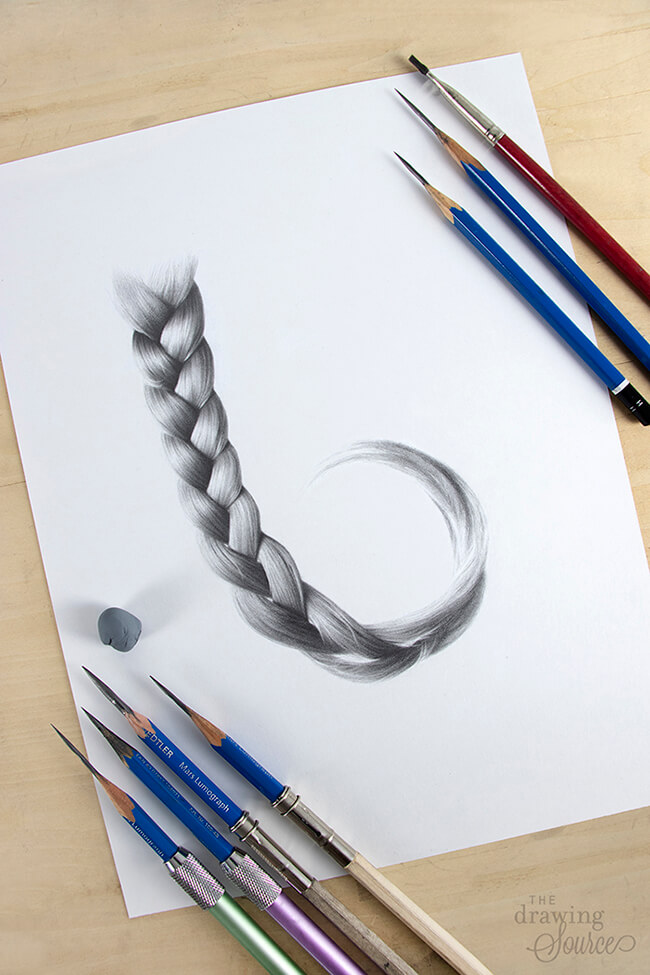
1. Drawing Board: A sturdy yet lightweight drawing board makes the drawing process much more comfortable.
2. Bulldog Clips: For attaching my paper to my drawing board.
3. Eraser: I use a simple kneaded eraser throughout this tutorial! I didn't have a need for any specialty, 'precision' erasers because kneaded erasers can be formed into any shape. Watch my video lesson on kneaded erasers, how to use them, and the 3 kneaded eraser techniques that I find most useful here.
4. Drawing Pencils: I am using H, HB, F, 2B, 4B and 6B Staedtler Mars Lumograph graphite pencils for this drawing. Notice how sharp they are in the image above: this was necessary for the final stages of the shading process (throughout my block-in and initial stages of shading, however, the leads were quite a bit shorter). Learn how to sharpen your pencils this way in this video.
5. Pencil Extenders: You might notice that some of my pencils are in pencil extenders, simply because they have been sharpened so often that they're too short to hold comfortably. I use the two styles of pencil extenders shown above and find them both equally comfortable.
6. Drawing Paper: I'm drawing on a sheet of Strathmore Bristol paper, which is a lovely, smooth drawing paper that I've recently grown fond of.
7. Inexpensive Paintbrush: I very briefly use an inexpensive paintbrush early on in the shading process to quickly cover up the white of the paper where I don't need it. However, this is just a convenience, and not at all a necessity.
Free Video Course on Essential Drawing Concepts
Throughout this lesson I refer to essential drawing concepts and stages of the drawing process. Learn about them in my free video course to get the most out of this tutorial!
How to Draw a Braid
Step 1: Gesture and General Proportions
Before you start any drawing, consider where you want it to be situated on your page. Consciously deciding where to place your drawing on your page is an easy way to start considering composition (and it's never too early to start thinking about composition!) Composition will become essential in creating a mood or conveying a story in your drawings later on, when you start creating more personal artworks rather than studies.
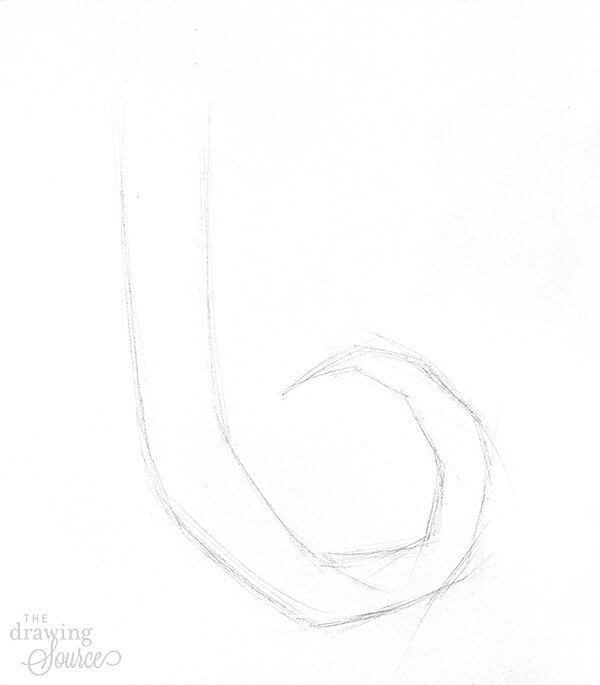 How to draw a braid: first step
How to draw a braid: first step
My first step is to find the gesture and general proportions of the braid. Even though this subject is made up of curves, I'm looking for major angle changes and indicating them with straight or slightly curved lines.
I sketch in my subject using light, erasable lines, and then use various methods of measurement to check how accurate my eye was at judging the proportions. For example, as shown below, I use comparative measurement to compare the width of the braid to its height. I find a convenient point to measure the width of the braid from: in this case, its outermost point on the right, where there is also an angle change. There is a video lesson on comparative measurement in my free Mini-Course.
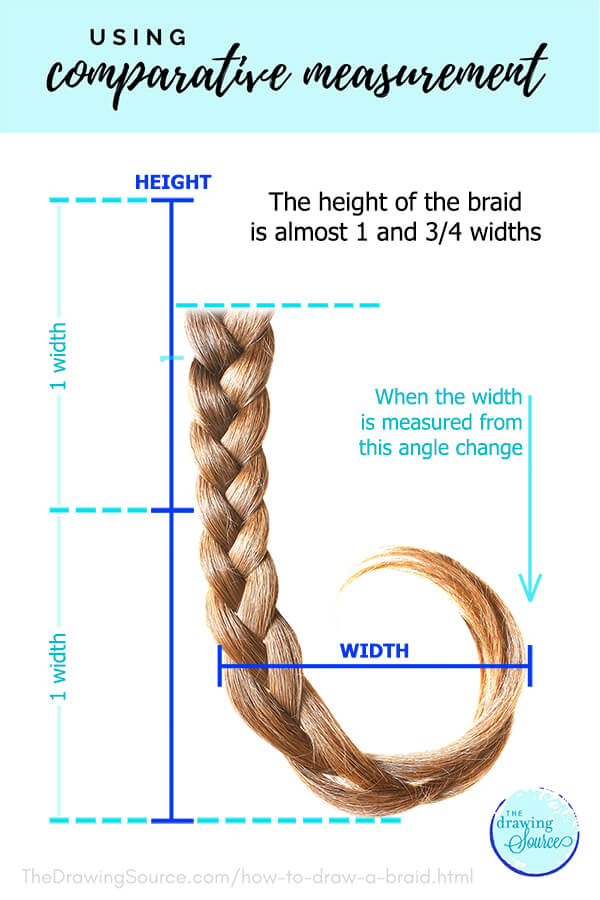
How to Draw a Braid
Step 2: Refining the Negative Space
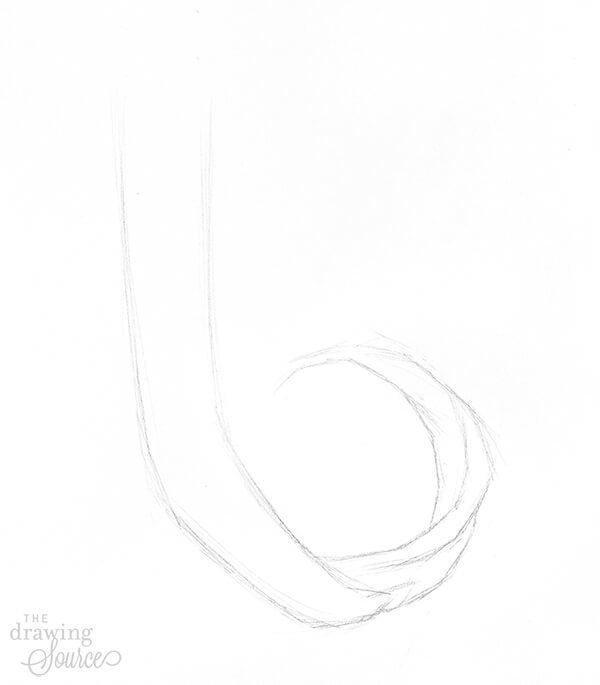
I decide to work on the drawing starting from the bottom, or end of the braid. This is because:
- The bottom right side of the braid has fairly distinct sections that will be easier to define, and
- I want to refine the negative space within the curl of the braid early on in the drawing, since it's important to the overall gesture of the subject.
I'm looking for the most obvious locks of hair here, and indicating where there are major angle changes or value changes.
Refining the Negative Space
To draw the negative space, I look at it 'from general to specific'. For example, when I look generally at the negative space, I'm viewing its overall shape and tilt. I notice that it's tilted to the left, and it's taller than it is wide. (I could even use comparative measurement here to compare its height and width.)
As I get more specific, I look for the location of the widest point of this negative space, and for the distinct angle changes that occur. Notice how many more angle changes I see when looking specifically (shown below).
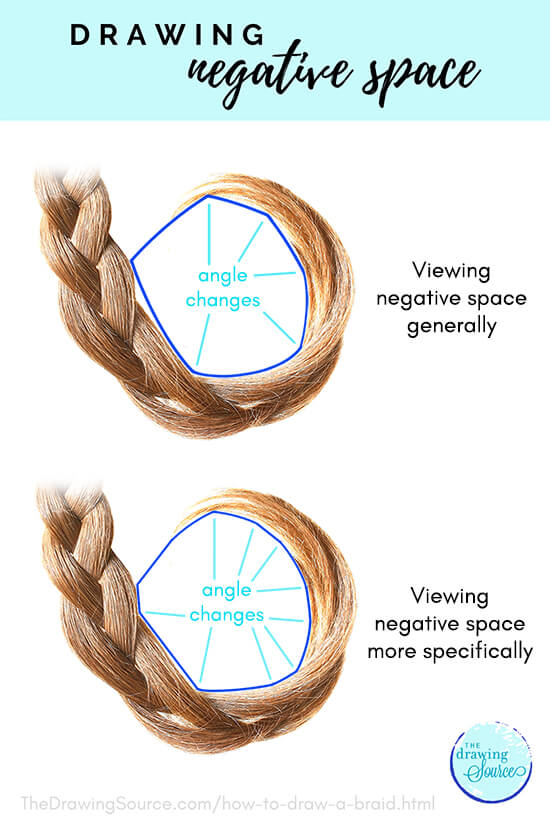
How to Draw a Braid
Step 3: Gesture Lines & Overlapping Lines
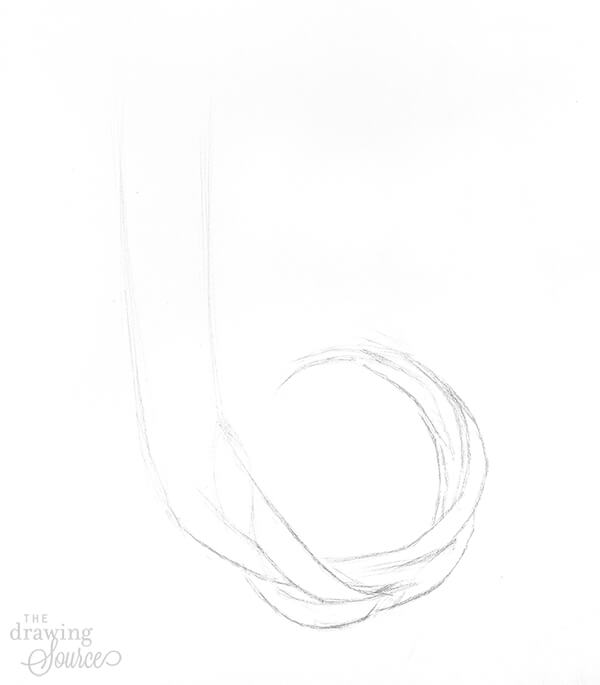
To draw a braid convincingly, it's essential that you have an understanding of two drawing concepts: gesture and overlapping lines. Gesture refers to the flow of one line into another. The line can be literal or implied (as shown below in Image 1). In drawing, every line flows into another line. This is true of most subject matters, but is particularly noticeable when drawing hair.
Overlapping lines occur whenever an object is in front of, or on top of, another object. Because a braid consists of three locks of hair woven together (or placed on top of one another in a pattern), it consists of a series of overlapping lines and gestures. Looking at the diagram below, notice that whenever a lock of hair is overlapped (intersected or interrupted), it doesn't abruptly end. If you follow the contour lines of the lock of hair, you'll notice that they continue on the other side of the intersection.
That's exactly what I do as I draw the braid: I follow a lock of hair to understand where its contour lines flow after it is overlapped by another lock of hair. For example, in Image 2 below, notice that Lock A is on top of Lock B. Making sure that the contour lines of Lock B connect on either side of Lock A (by using implied gesture lines) will create an interconnectivity and cohesiveness in my drawing, making it look natural and believable. Furthermore, this makes the process of drawing the block-in much easier, because you realize that none of these lines are random! They are all connected and flow into one another.
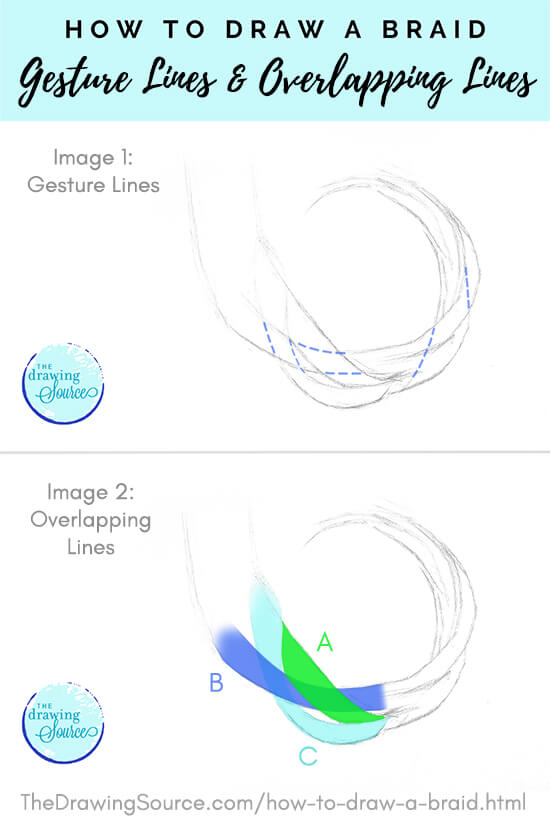
How to Draw a Braid
Step 4: Drawing a Specific Block-In
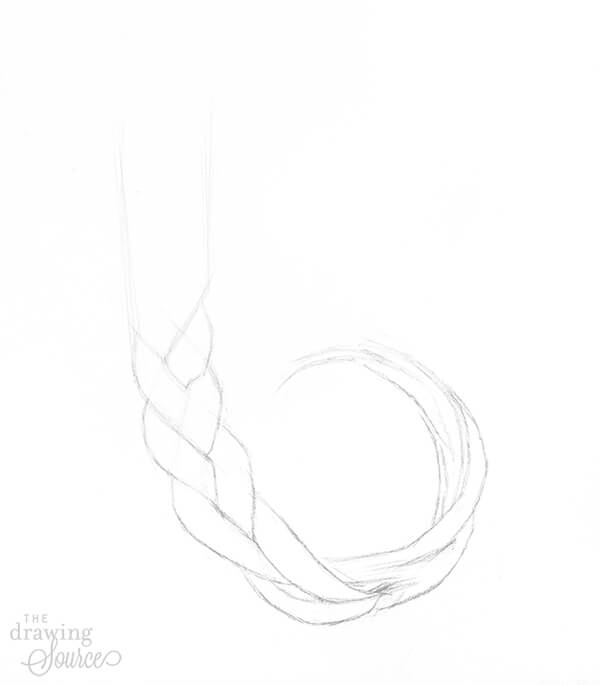
I continue "drawing through" the braid to make sure that each line of every lock of hair is continued after it is overlapped or intersected. I'm also looking for differences in each section of hair (see the image below). Each one has different widths and angles, creating unique shapes. The more closely you look at and compare the sections of hair, the more clearly you will see that each one has its own characteristics. The more specifically you draw these variations, the more realistic and natural your drawing will eventually look.
Notice that closer to the bottom of the braid, it becomes more loose. There are several small spaces between the locks of hair here. Towards the top we no longer see these because the braid tightens, and thickens. The narrowest part of the braid is approximately in the middle. From there it widens slightly towards the top and towards the bottom. These are the kinds of specifics that are necessary to pay attention to in order to draw a realistic braid.
To avoid getting lost in your drawing or your subject, as you look from one to the other, make mental notes of which curl you're working on – for example 'left side, third one down'.
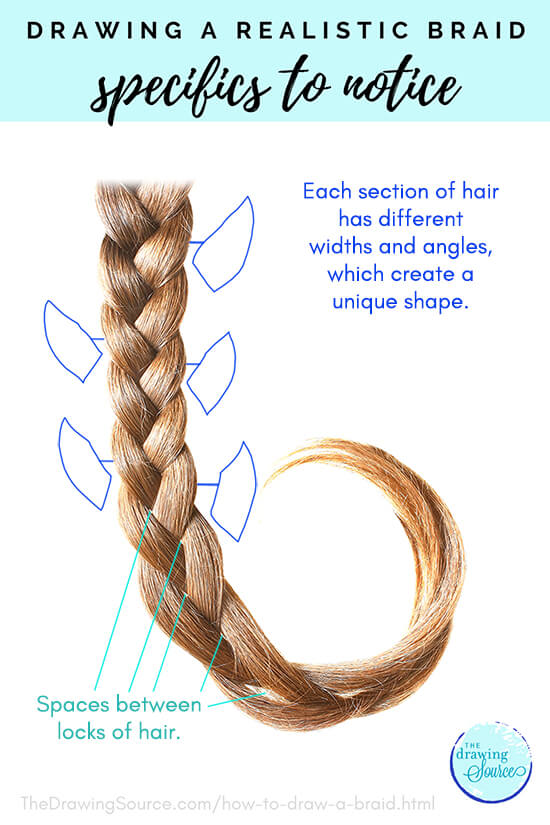
How to Draw a Braid
Step 5: Drawing Through the Form
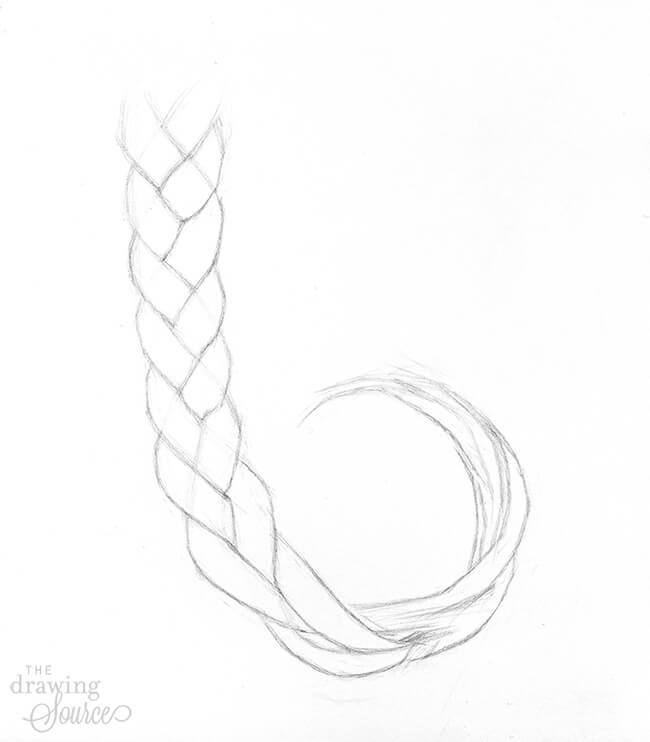
I continue "drawing through the forms" as though I can see through the braid, making sure each line flows into another line. You can see my "draw through" marks above, or more clearly in the illustration below.
If you're overwhelmed by this line drawing of the braid, take a look at its simplified structure in the diagram below. Technically, you can draw a braid by creating a zig-zagging center line, and then drawing curved lines from each point of the zig-zag upwards (illustrated below). If you're feeling like you could never draw a braid, give this a try! Though I don't use this method for this tutorial, and certainly further steps are needed to draw a braid realistically, this is a valid starting point and I present it to you to convince you that you absolutely can draw a braid.
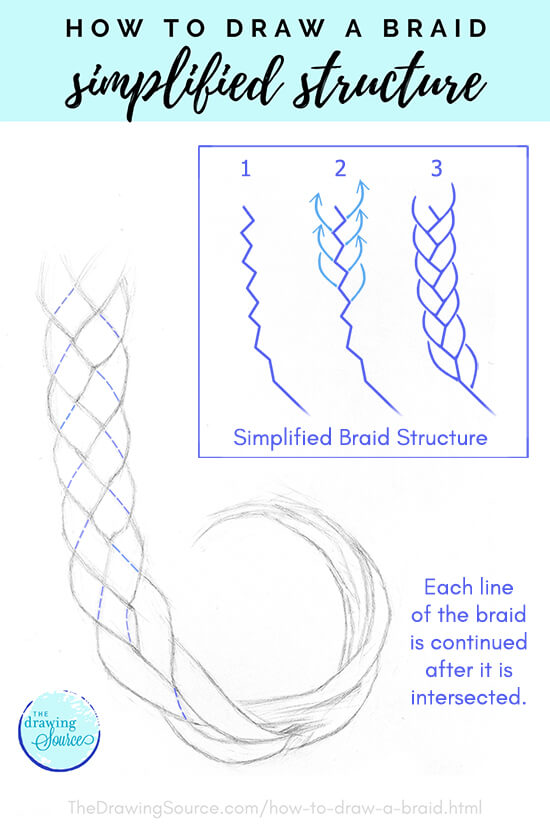
Once you're finished the 'first pass' of the block-in, as I am here, it's a good time to step back from your drawing. (Yes, physically stand up and step back.) It's easy to get caught up in detail and forget to view your drawing as a the whole, often missing important elements that form the bigger picture. Look at the overall gesture of the subject: Is it still present? Did it get lost? It's important to oscillate between 'zooming in' on certain areas of your subject and 'zooming out' of your subject throughout the entire drawing process.
Stepping back also gives you a break! Give yourself breaks from sitting (or standing, if you're drawing standing up), and from looking at your subject and your drawing. Walking away for a few minutes and then returning to your subject with fresh eyes can give you a new perspective and help you notice that which you previously hadn't, both on your subject and your drawing.
How to Draw a Braid
Step 6: Finishing the Block-In
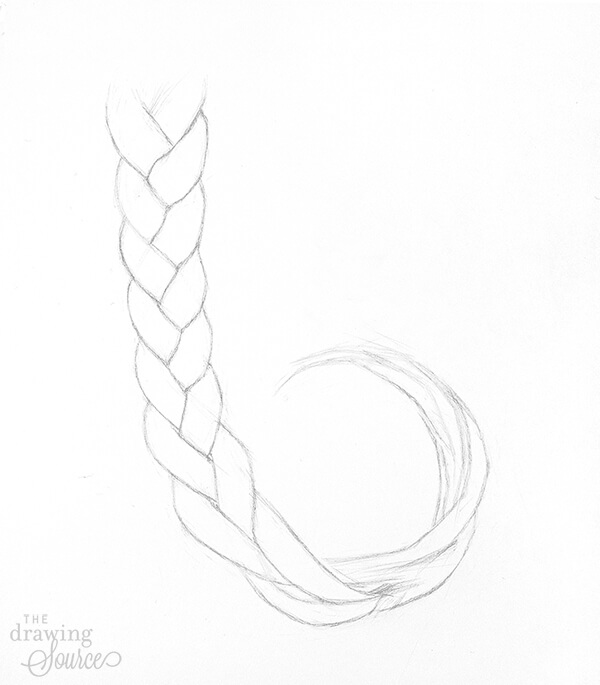 How to draw a braid: the finished block-in
How to draw a braid: the finished block-in
After erasing the gesture lines that were linking the locks of hair, I step back and consider: What constitutes a good block-in? In this case, I'm looking for my block-in to fulfill the following:
- It convincingly resembles the subject.
- It has a balance of accurate proportions and gestural movement.
- Its contour lines relate to the interior information of the subject.
- It contains all the information needed to move forward with the drawing successfully.
A final step I can take before adding values to my drawing is to indicate the shadow shapes in the braid. Or, since most of this subject consists of middle values, I can think of it as indicating the highlights instead (it will result in the same drawing, as shadow shapes and highlights share contour lines, or boundaries).
How to Draw a Braid
Step 7: Starting to Add Values
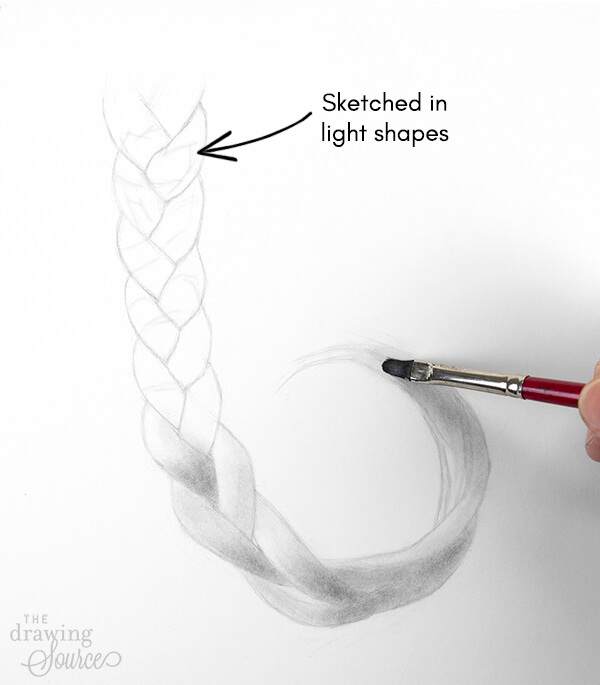
I combined a few steps here. First, I used my kneaded eraser to slightly lighten my block-in before beginning to add values. Why do this? Look at the contour of the braid in the reference photo (which you can download at the bottom of the page). Notice how much variation there is in the contour. In some areas it's in shadow. In other areas it's a middle value. In areas where light hits the outer hairs, the contour brightens so intensely that it merges with the white of the paper.
All this to say: while contour lines are extremely useful in creating a line drawing, try not to become attached to them, as they can easily detract from the realism of your drawing once you start shading. To avoid this, it's good practice to lighten the lines of your block-in before moving on to the value stage.
Next, I very lightly indicated where the light shapes are approximately located in the braid (shown in the image below).
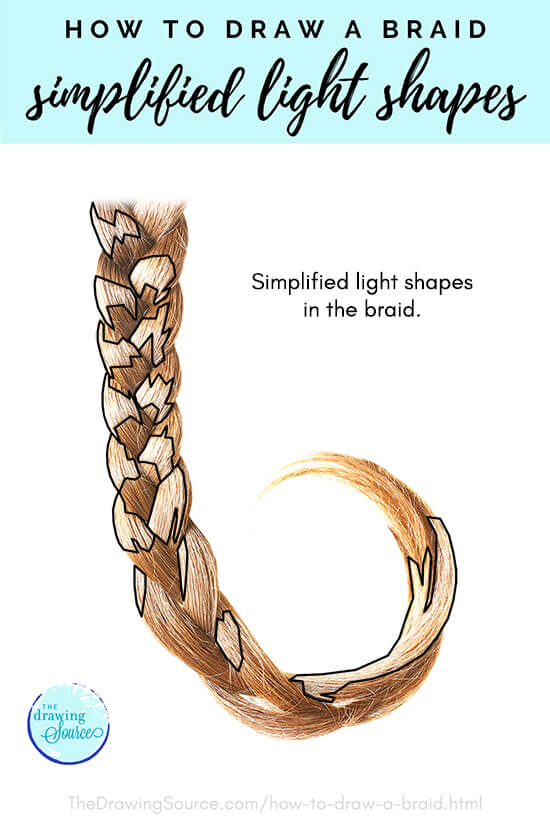
Finally, as I move into the value stage of this braid drawing, my first priority is to cover up the white of the paper where it's not needed. In this case, most of the drawing is darker than the white of the paper. To expedite this process, I'm using a paintbrush and some graphite powder to quickly put down a light value everywhere except for the highlight shapes that I pointed out in the previous image. I didn't have any graphite powder on hand, so I simply sharpened my pencil using a sandpaddle sharpener, and picked up some of the remaining graphite dust with my paintbrush.
How to Draw a Braid
A Brief Overview of Shading a Realistic Braid
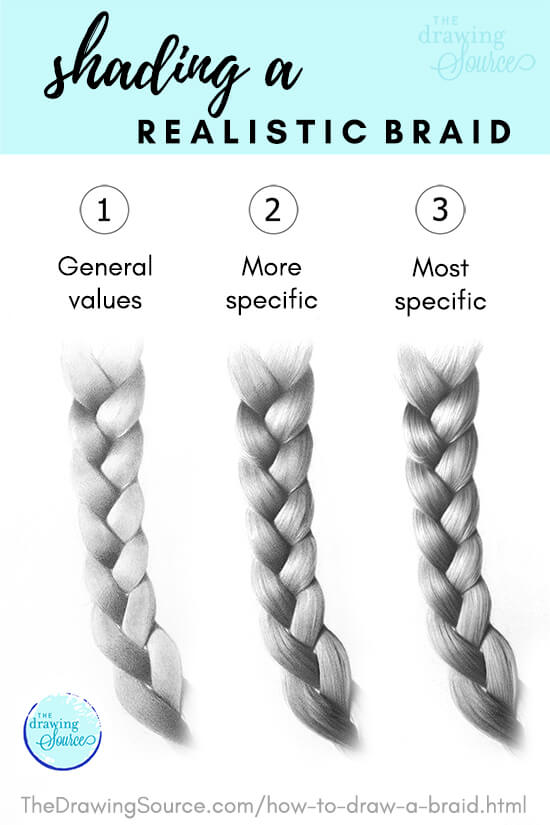
Shading a subject matter of this complexity is much less intimidating when you approach it in stages, or passes, from general to most specific. The process of shading a realistic braid can be summarized in this way:
Step 1: I begin by establishing the general value structure and edges of the braid (take my Mini-Course to learn about both of these!) My goal here is to view the braid as though it's made up of only 3 values: light, half-tone and dark, which can be achieved by squinting at the subject.
Step 2: I start looking at each segment of hair as its own entity, which has its own value extremes (lightest and darkest values), and distinct edge qualities. I'm finding smaller sections of more specific values within each segment of hair. In this stage I'm still searching for, rather than defining, all of these details, which is why they are still drawn fairly softly.
Step 3: I finally define the smallest, most specific details that I identified in the previous stage, though there are still choices to be made here - primarily how much detail you want to include in your drawing. This is a matter of personal preference and skill level. If you compare my drawing to the photo reference, you'll notice that much more detail is possible. But is it necessary? I decided that it wasn't.
I discuss the stages of shading in more detail and demonstrate the process of shading a subject from beginning to end in my video course: Realistic Drawing 101.
Let's look at the shading process in smaller steps.
How to Draw a Braid
Step 8: Building Up Values
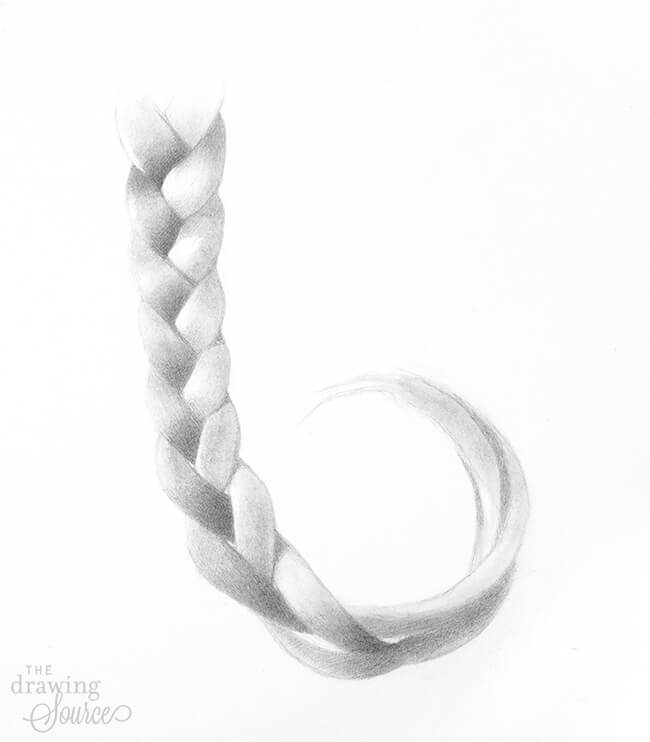 How to draw a braid: building up values
How to draw a braid: building up values
As I begin adding values to my drawing, my first goal is to view them as three simplified groups - light, half-tone (or middle value), and dark. I do this using the process illustrated below: I squint at my subject, causing much of its detail to blur together. I then aim to notice the general pattern of light, half-tone, and dark values (very generally at this point, perhaps even more generally than I illustrated below). I then start translating shapes of values onto my drawing, or in this case, a combination of shapes and gradations since many of the values in the braid flow into one another so smoothly.
Notice that the middle and dark values in my drawing are not yet at their full intensity. Since this subject consists of so many subtle value shifts, I'm going to incrementally darken my values. This will give me more opportunities to pay attention to the value relationships and placement of dark accents in my drawing.
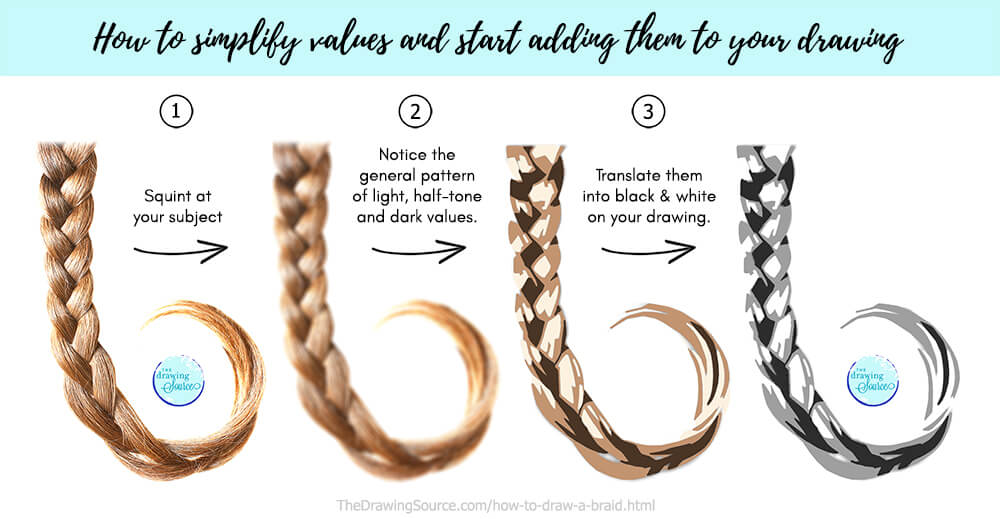
How to Draw a Braid
Step 9: Defining Value Extremes and Edges
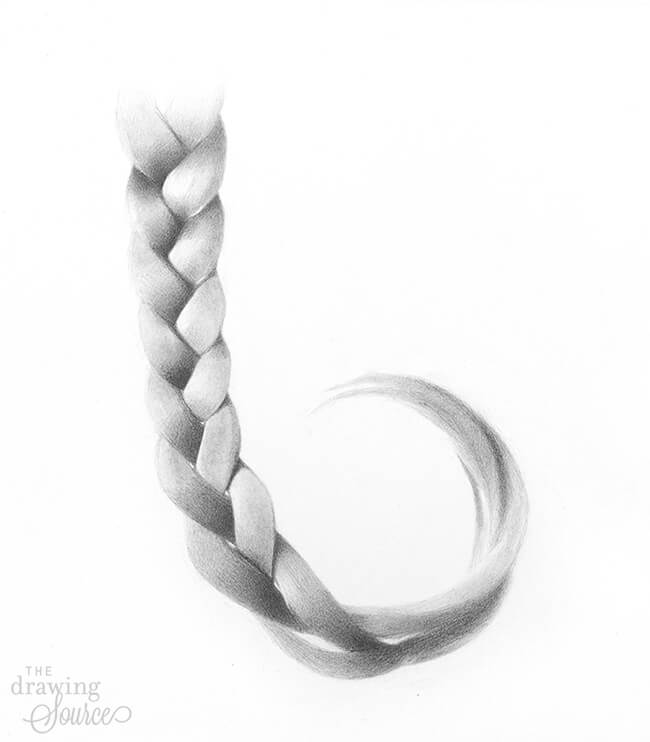
I'm building up and darkening the values, and I've started paying attention to edge quality. (Watch Lesson 6 of my free Mini-Course to learn about edges.)
As I analyze the value extremes in the braid, I'm looking to see where the darkest and lightest values are located, and evaluate how dark and light they actually are. For example, there are only a few small accents that approach a pitch black value. Same with the lightest values: there are only a few areas where the lightest values are actually white. The rest are slightly darker when compared to the white background.
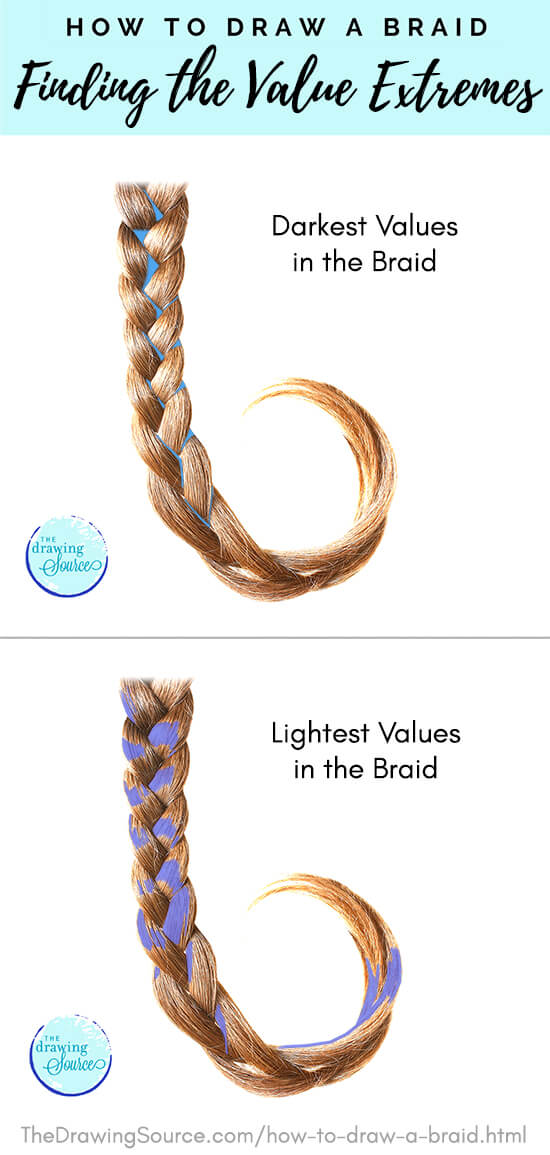
The darkest values are within the cast shadows of the braid, which are interesting and important areas to pay attention to. First, an important distinction: a form shadow occurs when a form turns away from light. These are noticeable on every section of braid. A cast shadow is caused by one object blocking light and therefore casting a shadow onto another object. (Read more about the elements of light and shadow on form on this page.)
Looking at the image below, notice where the cast shadows are located: on the right side of the braid, they are underneath each section of the braid. There are also thin slivers of cast shadows diagonally between the right and left locks of hair. In some areas, these are as thin as a line, and are easy to mistake as part of the form shadow (refer to the diagram below for clarification).
Finally, notice the differences in edge quality within a single cast shadow. Its top edge (where it begins, where it touches the form that is blocking the light) is sharp, while its bottom edge is considerably softer. Download the reference photo at the bottom of the page to zoom in and take a look at this important phenomenon!
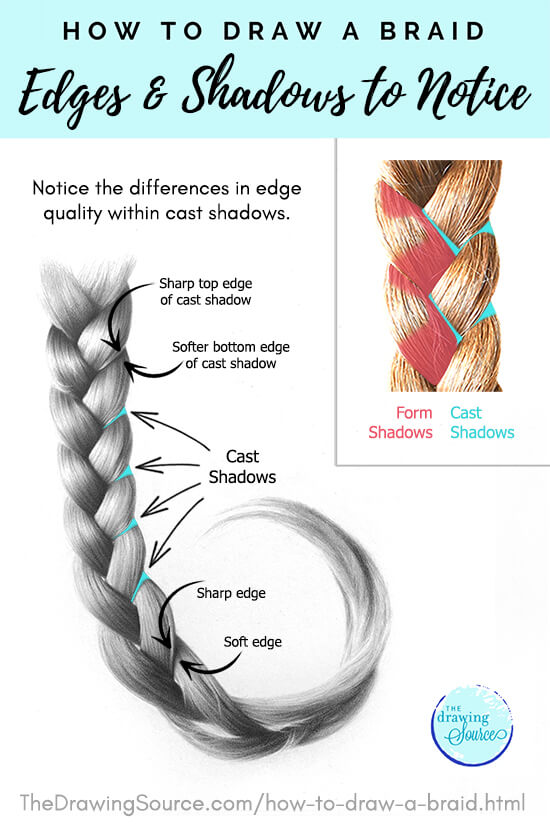
How to Draw a Braid
Step 10: Starting the Second Pass of Shading
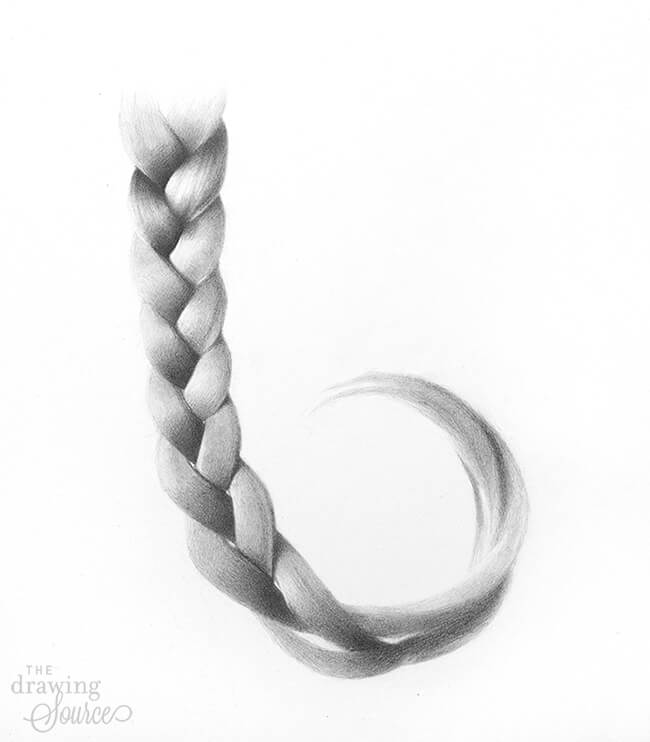 How to draw a braid: starting the second pass of shading
How to draw a braid: starting the second pass of shading
As I move into the second pass, or phase, of shading, I begin refining the braid at the top simply because it has one of the darkest shadows on the subject. This will be helpful for me to establish, and then use to compare the rest of my values to. I'm viewing each segment of the braid as its own entity, and for the rest of my drawing I'll be switching my 'mode of seeing' between this more specific, increasingly 'zoomed-in' vision, and a 'zoomed-out', more general vision of the whole subject.
Put another way, for the rest of the drawing I'll oscillate between viewing each segment of the braid as its own entity with its own value extremes and edges, and stepping back to view the entire braid as a whole.
How to Draw a Braid
Step 11: Shading the Middle of the Braid
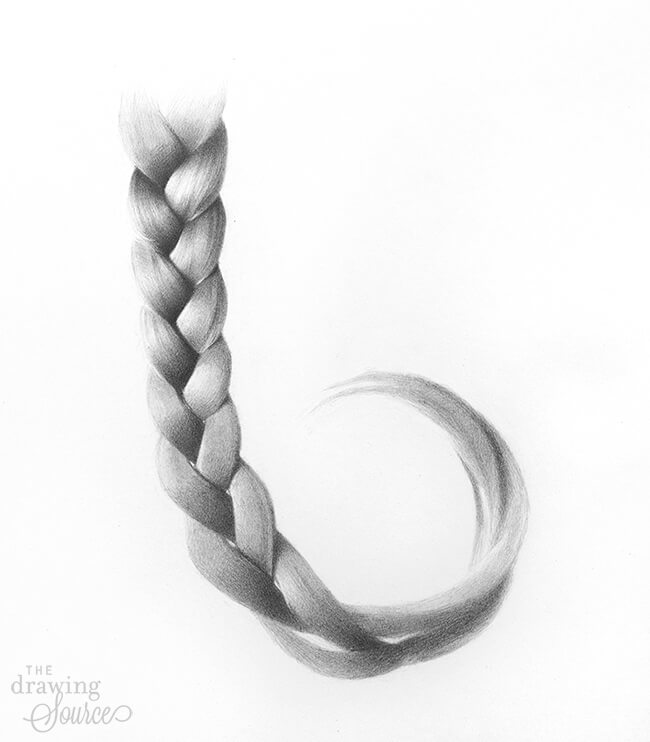
During this second pass of shading I'm not looking for individual hairs, but a 'medium' level of detail, so to speak (as shown in the image of the shading process overview earlier in the lesson).
As I work on each segment of the braid separately, questions I ask myself to guide my observation include: Where are the darkest values within this specific segment of hair? Where are the lightest values? Where are the most obvious 'sections', or divisions in the hair? For example, looking at the image below, notice the convenient, implied line that bisects this lock of hair diagonally.
Please note that it may take some time to 'tune your vision' to see the level of detail that you want. After viewing the subject more generally for the first stage of shading, that's what we're used to looking for and seeing! Now that we're looking to adjust our perception of the subject, you might find yourself 'zooming in or out' too much. However, as you look for the level of detail that you want, it will become easier to see.
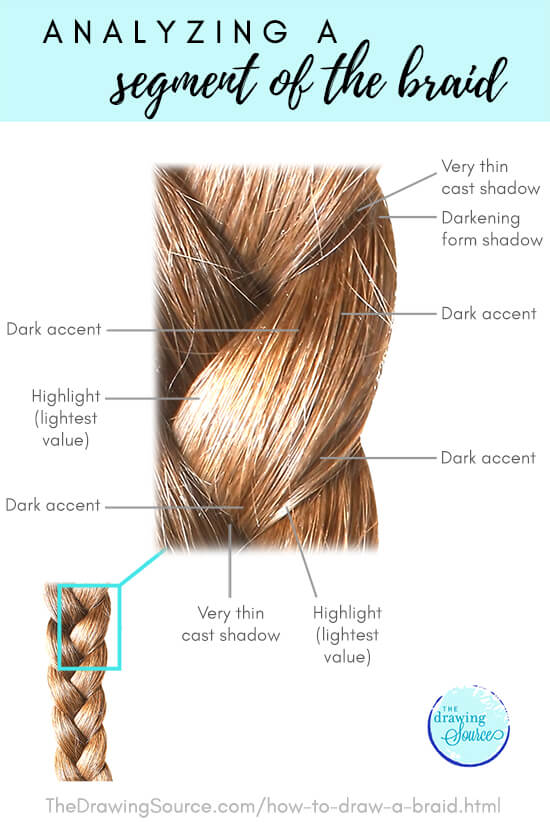
How to Draw a Braid
Step 12: Shading the Bottom of the Braid
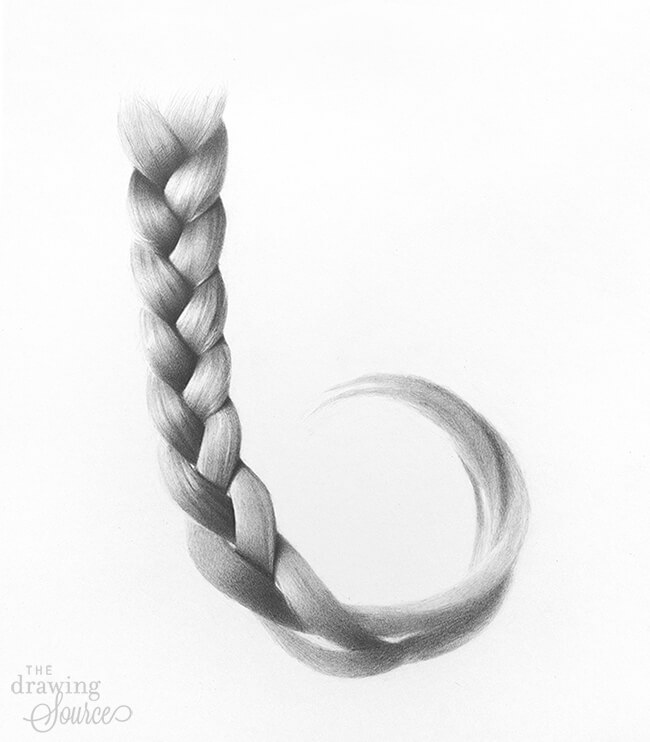
As I work my way down the braid, I'm using my kneaded eraser just as much as I'm using my pencil. The kneaded eraser is a tremendous drawing tool, as it can be shaped into any form, and used in various ways. I demonstrate my three favorite kneaded eraser techniques in this video. While drawing this braid, two techniques have been particularly useful:
- Shaping the kneaded eraser into a pencil point and using it as a kind of white pencil, and
- Flattening the kneaded eraser so that it has a sharp edge with which to create or lighten lines of value (both shown below)
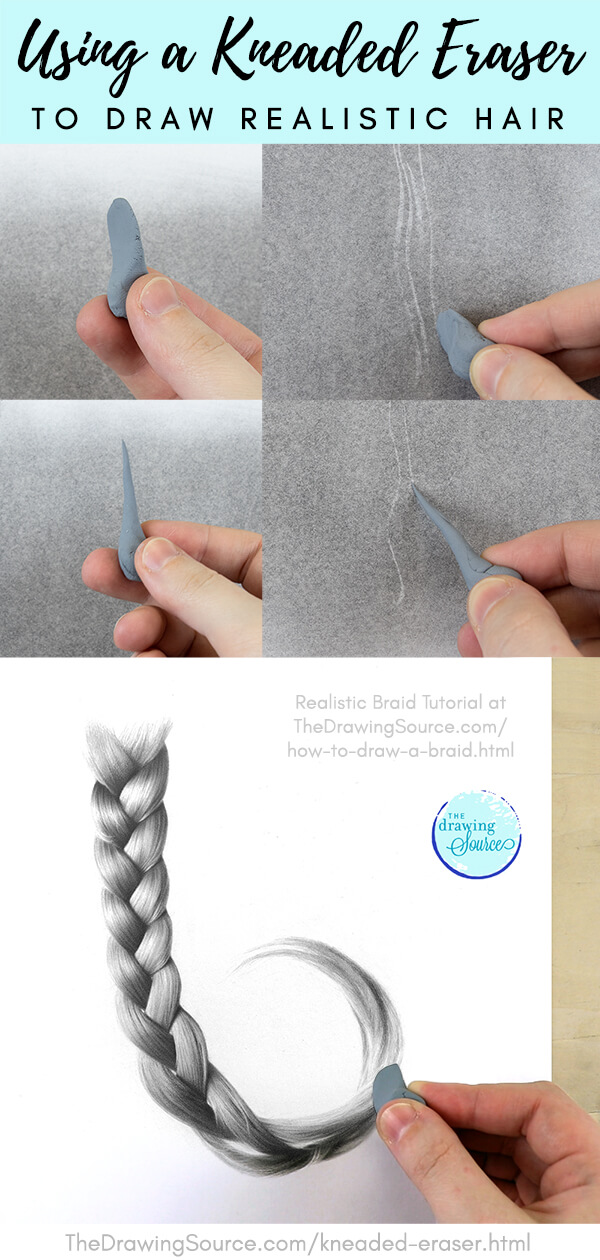
How to Draw a Braid
Step 13: Rendering the End of the Braid
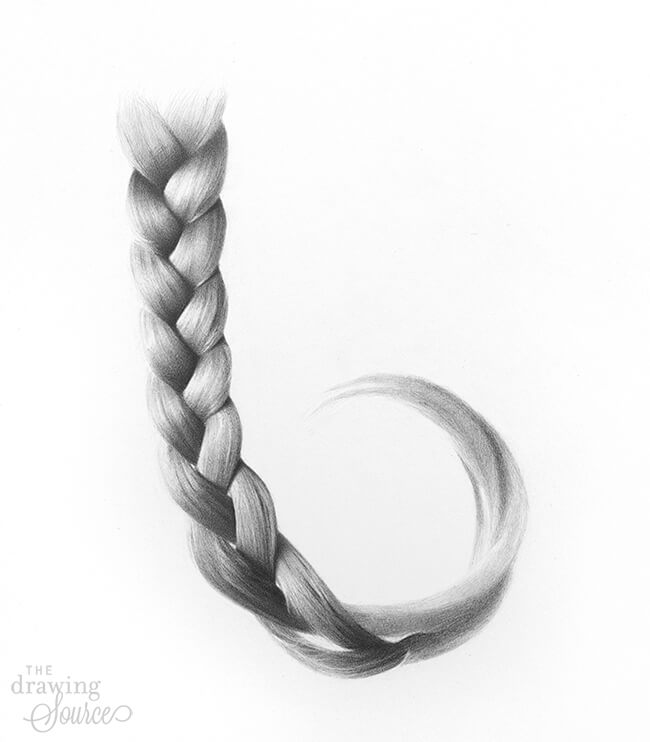 How to draw a braid: shading the end of the braid
How to draw a braid: shading the end of the braid
Just the 'tail' of the braid is left in my second pass of shading (notice that it's still looking very general compared to the rest of the drawing). My hand is constantly anchored as I work on more precise details. I demonstrate anchoring and the techniques I use to gain the most stability and control of my pencil in this video.
How to Draw a Braid
Step 14: Completing the Second Pass of Shading
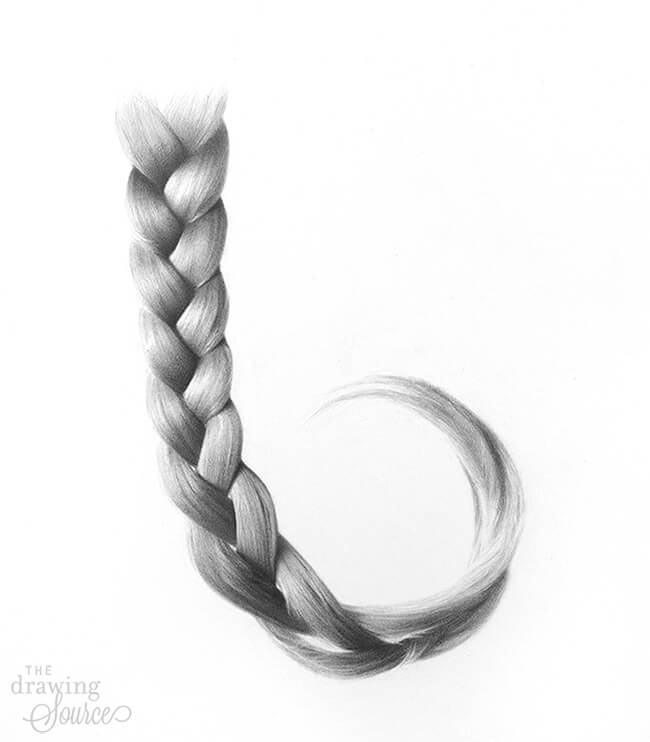 How to draw a braid: finished second pass of shading
How to draw a braid: finished second pass of shading
This concludes the second pass of shading (referring to the shading process overview that I discussed earlier in the lesson). The entire braid has been worked up to the same level of detail, though I am choosing to leave the end of the braid a little bit softer and more general so that it attracts less attention and appears to be farther back in space.
I'm confident that everything is in its place and can now focus on the delicious details!
How to Draw a Braid
Step 15: Delving into the Details
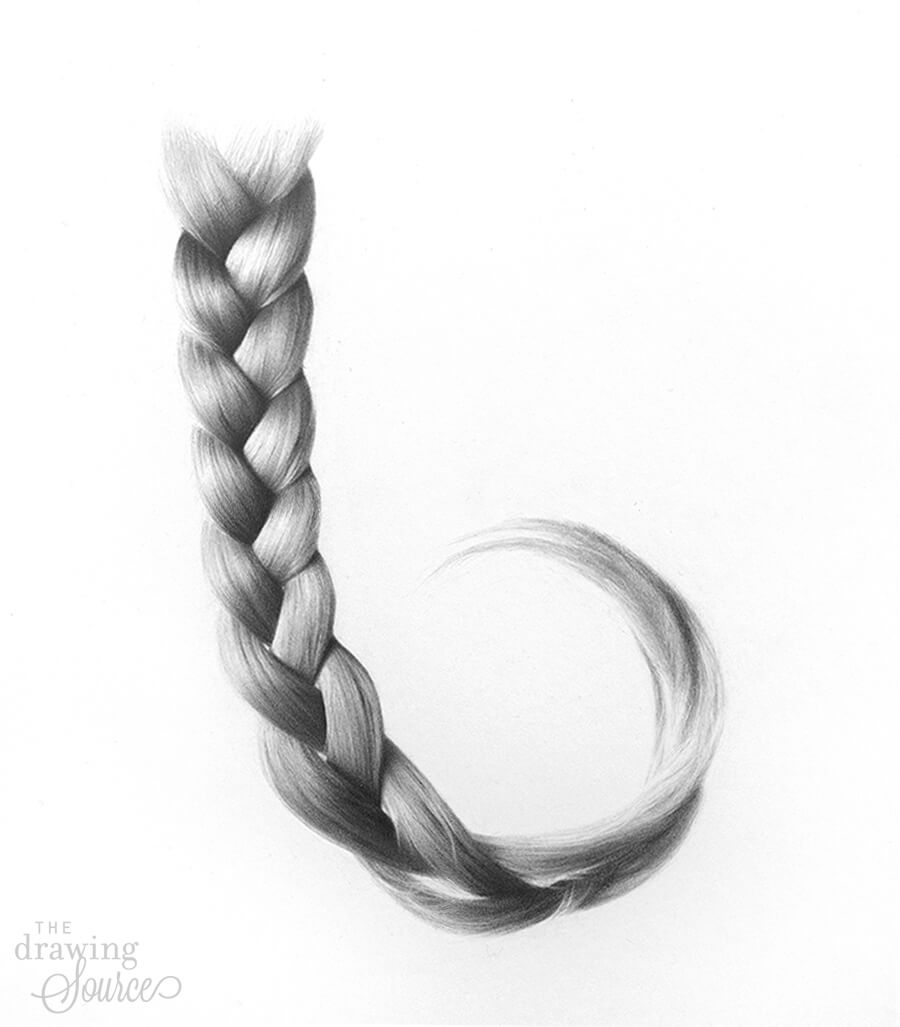
What I've done here:
- Sharpened the sharpest edges and created more of a distinct difference between sharp and soft edges
- Darkened the darkest accents now that I'm confident in their placement and clearly see that I can deepen them a little bit
- Created even smaller sections, or lines, of value in the drawing. I'm still not really thinking about individual hairs, and have only defined a few lone hairs in a few select places.
- Used a very sharp pencil to even out my values. View my entire shading process in my Realistic Drawing 101 Video Course!
The Finished Braid Drawing
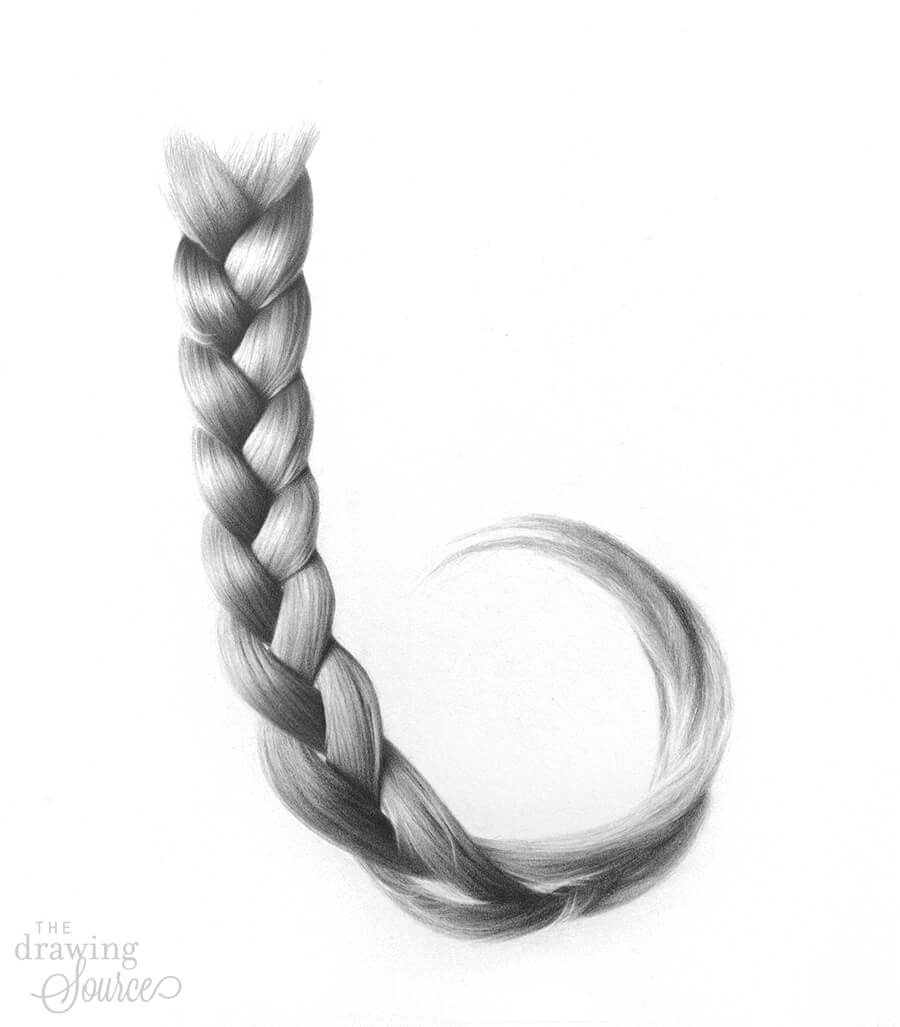
And here is my finished braid drawing! Could you refine a drawing of a complex subject matter such as this indefinitely? Absolutely! That's why it's important to learn how to decide when your drawing is finished. I dedicate the last video of my free mini-course to this very question.
I am quite happy to call this drawing finished. I enjoy that it is very realistic in some areas, yet still looks like a drawing in others. I love the quality of a drawing, and don't want to hide that that's what it is! I also look for a balance of simplicity and complexity in my drawings, and feel that I have achieved this here: there are more detailed, complex areas, as well as simpler ones.
I hope you enjoyed this tutorial on how to draw a braid! Don't forget to download the reference photo below, and check out my other hair drawing tutorial here.
Happy Drawing!
Your drawing prof,
![]()
![]()
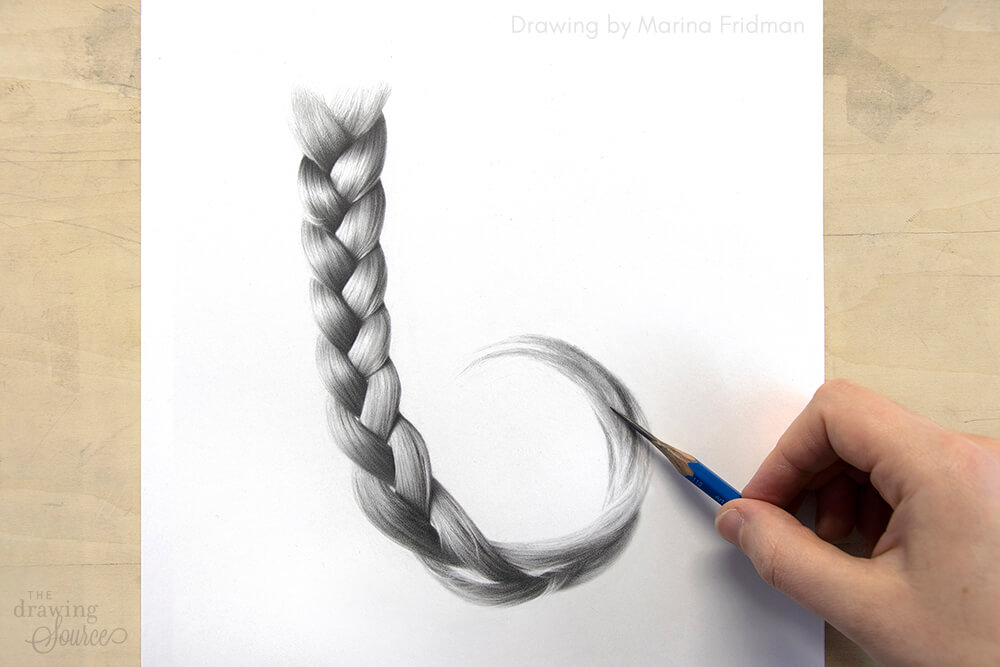
![]()
Downloadable Resources
Enjoyed this page? Please share it!
Share buttons and pinnable images below:
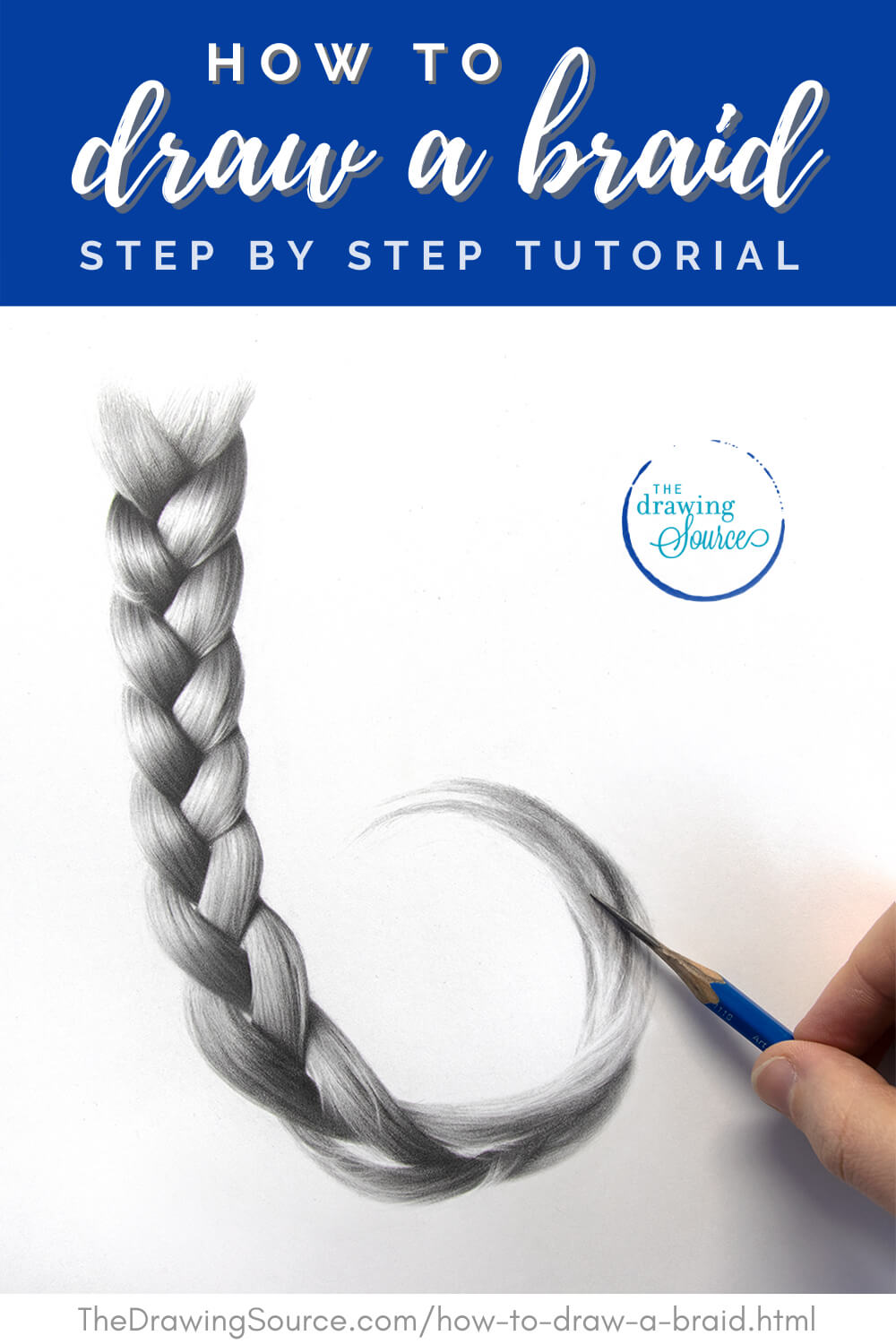
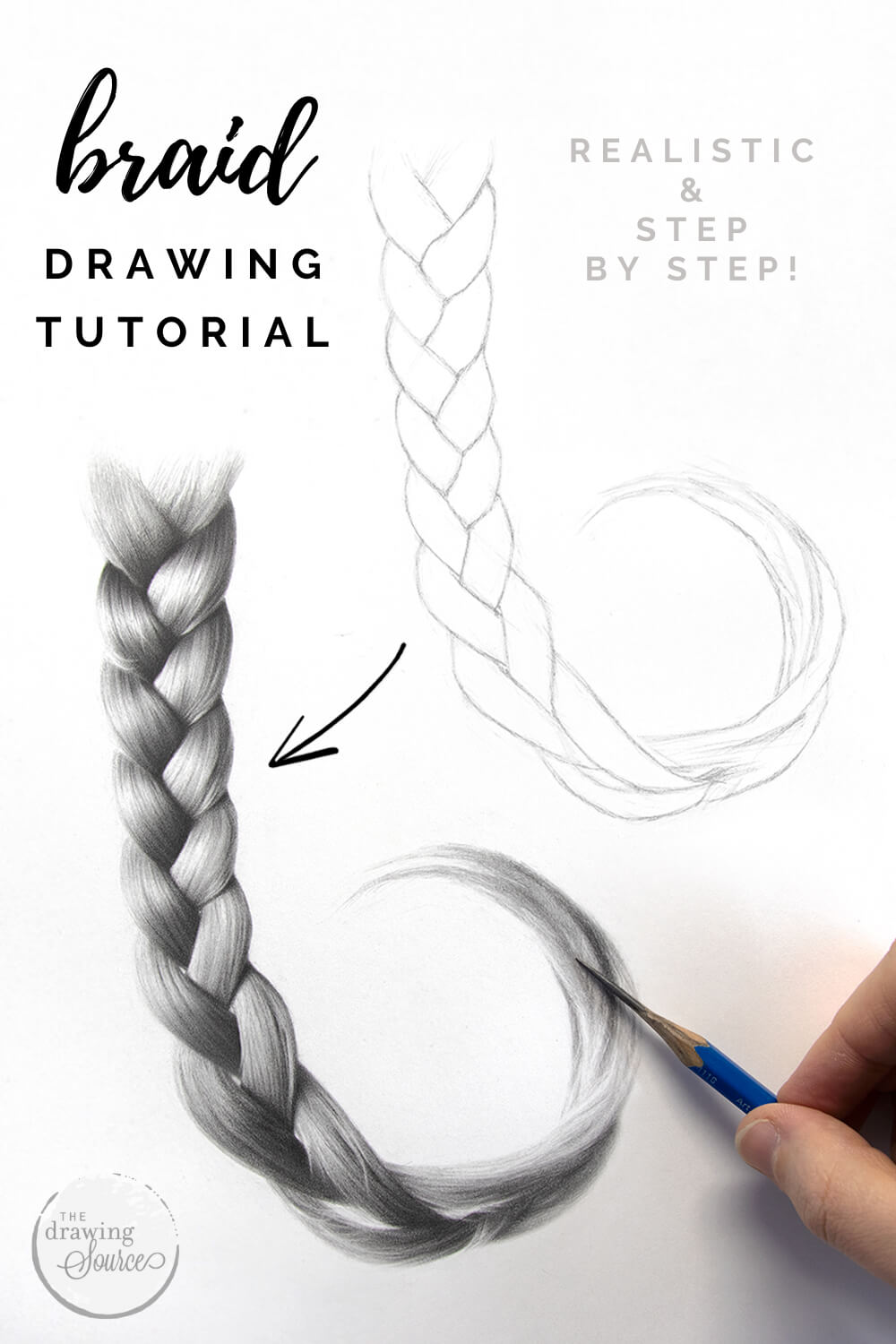
If you enjoyed this page on how to draw a braid, you may also be interested in:
Related Pages
How to Draw Hair (Step by Step)
Free Realistic Drawing Mini-Course
Collection of Portrait Drawing Tutorials
3 Useful Kneaded Eraser Techniques for Realistic Drawing
Return to Portrait Drawing from How to Draw a Braid
Hair Braid Drawing Step By Step
Source: https://www.thedrawingsource.com/how-to-draw-a-braid.html
Posted by: hensonkettere.blogspot.com

0 Response to "Hair Braid Drawing Step By Step"
Post a Comment